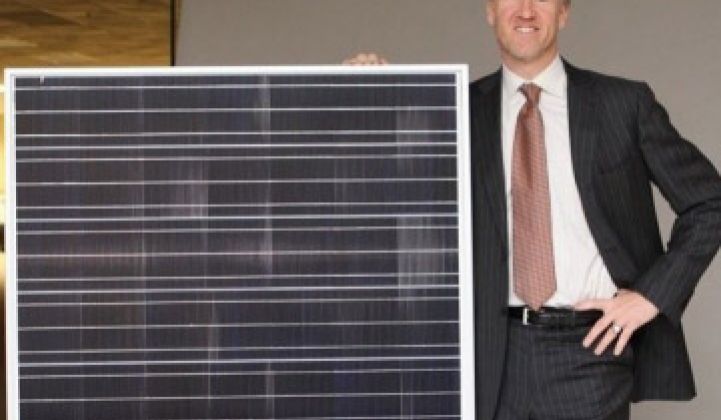Solaria believes in crystalline silicon. At a panel discussion late last year, Suvi Sharma, Solaria's President, made the arguable contention: "Aside from First Solar, there is no bankable thin-film."
Solaria builds crystalline silicon solar panels that look like standard form-factor 60-cell panels. They are about 14 percent efficient modules and put out approximately 230 watts. The twist is that Solaria concentrates the sunlight using a simple 2X lensing system and reduces the amount of silicon that goes into each panel by half. Additionally, Solaria claims it can ride innovation gains in crystalline silicon to produce cheaper and more efficient panels since the cell is 75 percent to 80 percent of the cost of the module. There is also a roadmap to 3X concentration.
Innovation gains such as what Innovalight is doing with silicon ink was one example cited by the CTO of Solaria, Kevin Giibson.
Dan Shugar, the CEO of the firm, has said that Solaria is trying to change the economics of the module without changing the industry. (That's Dan Shugar in the picture.) He said at an event late last year that "It's a very capital efficient way to grow the market without reinventing the industry."
CTO Gibson spoke at the monthly Silicon Valley Photovoltaic Society meeting held at PARC in Palo Alto this Wednesday on bringing new technology to the solar market.
Solaria's thesis is roughly this: most of the capital expense and cost in building a PV module is early in the process -- in silicon, ingot, wafer, and cell. By reducing the amount of silicon, Solaria claims that the price of the module is reduced and the capex required to get the solar industry to meaningful scale (i.e., to 50 gigawatts or to 100 gigawatts) is vastly reduced. The plan is to replace expensive photovoltaics with low-cost optics.
They break it down like this -- to get to ten gigawatts of c-Si capacity requires:
- Silicon capex $10 billion to $15 billion
- Ingot capex $3 billion
- Wafer capex $2 billion
- Cell capex $5 billion
- Module capex $1 billion
- For a total of approximately $25 billion to add 10 gigawatts of c-Si module capacity
Shugar, the CEO, has said that, "There's really five factories." In China the money to finance those factories can come from the China Development Bank. But where will it come from in the U.S?
Solaria believes their low-concentration module will allow the U.S. industry to scale faster and cheaper. Solaria is essentially a "fabless" PV module design.
Gibson provided a history of the firm, which had initially looked at high-concentration PV and a number of different low-concentration approaches. They eventually adopted, as their first commercial product, a 2X design on an acrylic carrier. That design was recently scrapped in favor of the more current and lower-cost architecture. The firm "singulates" silicon wafers into small strips and mounts those small strips under the scalloped 2X lens surface of the front glass. Other than that, the module uses standard EVA, low-iron float glass, backsheet, and ribbon, so the firm "does not have to design a whole new infrastructure," according to Gibson.
Solaria is well-capitalized with a recent $55 million round and a total of more than $127 million invested by Sigma Partners, NGEN, DBL, CMEA, enXco, Q-Cells, et al.
The firm has a five-year supply deal with EnXco and claims that it is shipping worldwide.
Because the glass is thicker, the module is more impact resistant and that also allows the frame to be eliminated. Solaria considers it "an application-specific module" that is meant to be used on a tracker and garner the 20 percent to 30 percent more energy from tracker technology. The thicker glass does add some weight to the module.
Embedded energy is less than that of a standard c-Si panel with an Energy Payback (EPB) of less than a year and a plan of getting it down to .75 years.
It's always a knowledgeable crowd at SVPVS events, and at PARC, and they asked Gibson tough questions.
The questions probed the CTO about temperature issues, cleaning and soiling of the textured glass, and cost. The CTO was well-prepared on all of the technical questions. Shugar has also provided answers for these questions in the past. The CTO said that the temperature for the Solaria module is about the same for a standard module despite the concentration and that soiling issues and water spots were issues confronted by all panel vendors.
The CTO passed on questions of cost.
The bottom line is that Solaria has to prove itself as bankable, and once that's accomplished, the firm must compete head-to-head with the likes of China's Trina Solar and Yingli with module costs in the neighborhood of $1.10 per watt.
Can Solaria compete against the pricing of those vertically integrated Chinese powerhouses? We'll know more in 2011 and 2012.



